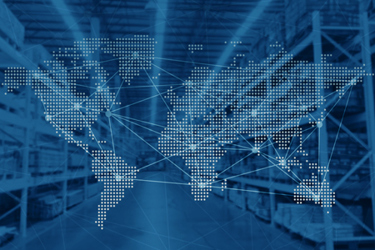The 4 Technologies Poised To Transform The Pharmaceutical Supply Chain In 2025 And Beyond
By Christopher Ohms, Ohms Consulting

Predicting specific advancements in the pharmaceutical supply chain over the next decade involves a degree of speculation, yet several trends and potential developments can be anticipated based on current technological trajectories. Maintaining the optimal health of the pharmaceutical supply chain — focused on efficiency, reliability, and resiliency — will be critical. This concept of “health” doesn't directly relate to patient well-being but rather to the robustness and effectiveness of the infrastructure delivering investigational medicinal products (IMPs) and commercial supplies.
In the coming decade, technological advancements like blockchain technology, sensor integration, robotics and automation in warehousing, and advanced planning tools are expected to significantly impact the pharmaceutical supply chain. These technologies promise to transform how pharmaceutical products are manufactured, tracked, stored, and distributed, ensuring that the supply chain remains resilient in the face of various challenges.
1. Blockchain Technology: Enhancing Transparency And Security
Blockchain technology is poised to revolutionize transparency, traceability, and security across pharmaceutical supply chains. By leveraging decentralized and immutable ledgers, blockchain offers a secure and transparent method to track the entire life cycle of pharmaceutical products, ensuring each step of a product's journey is securely documented.
For instance, in clinical trials, blockchain can monitor the sourcing of IMPs, track storage conditions, record transactions, and verify batch authenticity. Consider a global clinical trial scenario where each pharmaceutical product — whether a vial, ampoule, blister card, or bottle — is assigned a unique identifier like a QR code or serial number, recorded on a blockchain ledger. This digital fingerprint allows stakeholders to verify authenticity throughout the product's life cycle, from manufacture to distribution to patient administration.
Real-time access to blockchain records facilitates accurate inventory management, recall management, and compliance with regulatory standards. For example, automated alerts can be triggered if predefined conditions, such as temperature thresholds, are breached. Additionally, blockchain supports the creation of digital identities for pharmaceutical products, enabling instant verification of authenticity — a crucial measure in combating counterfeit medications and ensuring patient safety.
A practical example of blockchain’s impact can be seen in IBM’s collaboration with KPMG, Merck, and Walmart to create a blockchain-based pharmaceutical supply chain. This initiative was part of an FDA pilot program aimed at improving the traceability of prescription drugs. By integrating blockchain, the participants were able to track the entire supply chain process — from manufacturing to distribution — thereby enhancing the security and reliability of the drug supply.
2. Sensor Integration: Safeguarding Product Integrity
Sensor technology plays a critical role in maintaining pharmaceutical product integrity across clinical and commercial supply chains. Sensors monitor environmental factors such as temperature, humidity, and location in real time, enabling proactive management of conditions that could impact product quality.
For temperature-sensitive medications, sensors integrated into packaging ensure compliance with storage requirements during transportation and storage, alerting stakeholders to deviations that could compromise potency. For example, a shipment of vaccines traveling across different climate zones can be monitored in real time to ensure they remain within required temperature ranges. Companies like Sensefinity, LogTag, Elpro, and Sensitech offer wireless sensor devices that can monitor temperature, humidity, shock, and light exposure in real time. These sensors are often connected to cloud-based platforms, enabling continuous monitoring and ensuring compliance with storage conditions.
In practice, a major pharmaceutical company has employed sensor technology to monitor the distribution of its COVID-19 vaccine, which requires storage at ultra-low temperatures. It used GPS-enabled thermal sensors that continuously tracked the location and temperature of each vaccine shipment across the supply chain. This real-time data allowed for immediate corrective actions if any shipment was in danger of falling outside of the required temperature range, thereby ensuring that the vaccines maintained their efficacy upon reaching the end user.
3. Robotics And Automation In Warehousing: Streamlining Operations
In warehouse operations, robotics and automation technologies are streamlining processes such as picking, packing, and shipping. Automated systems equipped with computer vision and machine learning algorithms enhance accuracy and scalability while reducing reliance on manual labor and mitigating human errors.
Robotics automate tasks like order fulfillment, inventory tracking, and documentation generation, accelerating operational efficiency and ensuring compliance with regulatory requirements. For example, robotic systems in pharmaceutical warehouses can pick and package drugs more quickly and accurately than human workers, reducing the risk of errors and speeding up the distribution process. The integration of robotics and automation in warehousing depots promises significant improvements in supply chain management, enabling faster turnaround times and enhanced inventory control.
One notable example of robotics in pharmaceutical warehousing is the use of automated guided vehicles (AGVs). These AGVs are employed to transport goods within the warehouse, reducing the need for manual handling and increasing efficiency. Additionally, automated storage and retrieval systems (AS/RS) are used to manage inventory, further optimizing warehouse operations by ensuring that products are stored and retrieved in the most efficient manner possible.
4. Advanced Planning Tools: Optimizing The Supply Chain
Advanced planning tools are becoming increasingly vital in optimizing the pharmaceutical supply chain. Solutions like those provided by RapidResponse, MRPEasy, and ABCplan offer robust features for demand forecasting, resource allocation, and production planning. These tools help pharmaceutical companies anticipate demand, manage inventory levels, and coordinate supply chain activities more effectively.
If your pharmaceutical company is small or mid-size, consider software that is particularly well-suited for your business. I recommend looking for an intuitive platform that simplifies complex planning tasks, offering a middle ground between the basic functionality of Excel and the more complex, costly systems. One key feature you will want to look for is that its software displays real-time data (i.e., IMP distributed, units sold, etc.) across the supply chain. This integration allows companies to create accurate demand forecasts based on historical sales data, clinical trial outcomes, and market trends. For example, if your pharma company is preparing to launch a new medication, one may use historical data entered into the software to analyze data from previous product launches and current market conditions to predict demand, ensuring that production levels are appropriately scaled. Moreover, select software products have scenario planning capabilities that enable companies to prepare for potential disruptions.
How Can The Above Technologies Address Common Pain Points For Supply Chain Resiliency?
In the pharmaceutical supply chain, resiliency is essential to ensure a continuous supply of essential medications, even in the face of disruptions. Several strategies and technologies can be employed in combination to enhance resiliency, particularly considering safety stocking, geopolitical risks, and legislative measures like the BIOSECURE Act.
- Safety Stocking: Maintaining an adequate safety stock of critical medications and raw materials is a fundamental aspect of supply chain resilience. Safety stocks act as a buffer against unexpected demand surges or supply chain interruptions. Advanced planning tools can help determine optimal safety stock levels by analyzing historical demand patterns, lead times, and supply chain variability. For instance, during the early stages of the COVID-19 pandemic, some pharmaceutical companies that had maintained robust safety stocks were better equipped to handle the sudden surge in demand for certain medications.
- Geopolitical Risks: Geopolitical risks, such as trade restrictions, tariffs, and political instability in key manufacturing regions, can significantly impact the pharmaceutical supply chain. Blockchain technology can mitigate some of these risks by providing greater transparency and traceability across international borders. For example, blockchain can verify the origin of raw materials and ensure compliance with trade regulations, reducing the risk of supply chain disruptions due to geopolitical tensions.
- Legislative Acts (Such As The BIOSECURE Act): Legislation like the BIOSECURE Act, which aims to strengthen the resilience of the U.S. pharmaceutical supply chain, emphasizes the importance of domestic production capabilities and supply chain security. Software and internal processes combined can support compliance with such legislative requirements by providing tools for monitoring and reporting on the domestic sourcing of materials, ensuring that companies meet the act’s mandates.
Moreover, the combination of blockchain and sensor technologies can enhance compliance with the BIOSECURE Act by providing a secure and transparent record of every step in the supply chain, from raw material sourcing to final product distribution. This level of detail helps pharmaceutical companies demonstrate compliance with government regulations and respond quickly to any audits or inquiries.
As the pharmaceutical industry continues to evolve, the integration of advanced technologies like blockchain, sensor integration, robotics, automation, and advanced planning tools will play a pivotal role in shaping the future of supply chain management. These innovations, coupled with emerging trends in data analytics, AI, and personalized medicine, will enable companies to optimize their operations, enhance transparency, and ensure compliance with increasingly stringent regulations. The focus on supply chain resilience, informed by lessons from global disruptions like a pandemic or potential trade restrictions, will be crucial in preparing for future challenges. Moreover, the growing emphasis on sustainability will drive the adoption of eco-friendly practices, further transforming the pharmaceutical supply chain. By embracing these advancements and trends, the pharmaceutical industry is poised to deliver more efficient, reliable, and resilient supply chains, ultimately improving global healthcare delivery and ensuring that essential medications reach those who need them most.
 About The Author:
About The Author:
Christopher Ohms is a consultant at Ohms Consulting and is a San Francisco Bay Area native. He has held positions at Gilead Sciences, Patheon, Stanford School of Medicine, Pain Therapeutics, and ALZA.
